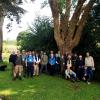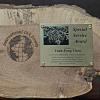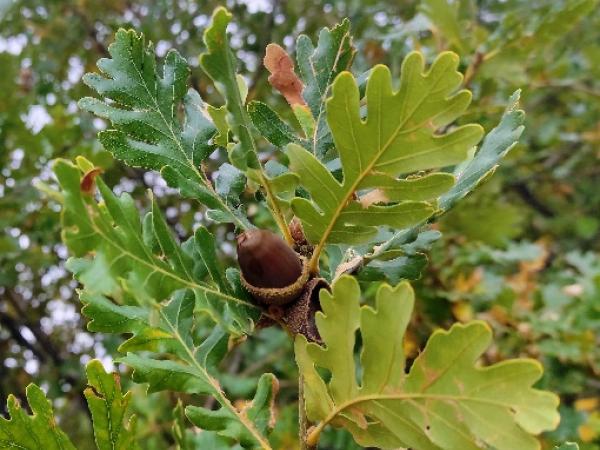Editor's Picks
Plant Focus
Prahlada Papper
Published May 2019 in International Oaks No. 30: 185–190
Abstract
The maintenance of reproductive compatibility within taxonomic sections of the genus Quercus despite long evolutionary divergence supports Van Valen’s theory of the multispecies evolutionary complex. If Van Valen’s theory is correct, hybridizing oak species should remain distinct even with prolonged reproductive contact. I tested this prediction in the hybridizing Q. douglasii (blue oak) and Q. garryana var. garryana (Oregon white oak) by modeling their geographic distributions through the most recent glacial cycle. Species distributions for the last glacial maximum (21,000 years ago), the mid-Holocene climate optimum (6,000 years ago), and the historical period (1951 to 2010) show that, though the ranges of both species have shifted considerably, they have continuously maintained a zone of sympatry. The potential for gene flow between Q. douglasii and Q. garryana var. garryana across this contact zone has persisted for tens of thousands of years, and possibly throughout the entire 2.6-million-year Quaternary Period, supporting the conclusion that they are a multispecies evolutionary complex sensu Van Valen.
Keywords
gene flow, species distribution model, last glacial maximum, mid-Holocene, multispecies complex
References
Braconnot, P., S.P. Harrison, M Kageyama, P.J. Bartlein, V. Masson-Delmotte, A. Abe-Ouchi, B. Otto-Bliesner, and Y. Zhao. 2012. Evaluation of climate models using palaeoclimatic data. Nature Climate Change 2: 417-424.
Daly C, M. Halbleib, J.I. Smith, W.P. Gibson, M.K. Doggett, G.H. Taylor, J. Curtis, and P.P. Pasteris. 2008. Physiographically sensitive mapping of climatological temperature and precipitation across the conterminous United States. International Journal of Climatology 28(15): 2031-2064.
Davis F.W., D.M. Stoms, A.D. Hollander, K.A. Thomas, P.A. Stine, D. Odion, M.I. Borchert, J.H. Thorne, M.V. Gray, R.E. Walker, K. Warner, and J. Graae. 1998. The California Gap Analysis Project: Final Report. Santa Barbara, CA: University of California.
Gent P.R., G. Danabasoglu, L.J. Donner, M.M. Holland, E.C. Hunke, S.R. Jayne, D.M. Lawrence, R.B. Neale, P.J. Rasch, M. Vertenstein, P.H. Worley, Z.-L. Yang, and M. Zhang. 2011. The Community Climate System Model version 4. Journal of Climatology 24(19): 4973-4991.
Gugger, F., M. Ikegami, and V.L. Sork. 2013. Influence of late quaternary climate change on present patterns of genetic variation in valley oak, Quercus lobata Née. Molecular Ecology 22(13): 3598-3612.
Herbert, T.D., J.D. Schuffert, D. Andreasen, L. Heusser, M. Lyle, A. Mix, A.C. Ravelo, L.D. Stott, and J.C. Herguera. 2001. Collapse of the California Current during glacial maxima linked to climate change on land. Science 293(5527): 71-77.
Hipp A..L, P.S. Manos, A. González-Rodríguez, M. Hahn, M. Kaproth, J.D. McVay, S. Valencia Avalos, and J. Cavender-Bares. 2017. Sympatric parallel diversification of major oak clades in the Americas and the origins of Mexican species diversity. New Phytologist 217(1): 493-452.
Kim, B.Y., X. Wei, S. Fitz-Gibbon, K.E. Lohmueller, J. Ortego, P.F. Gugger, and V.L. Sork. 2018. RADseq data reveal ancient, but not pervasive, introgression between Californian tree and scrub oak species (Quercus sect. Quercus: Fagaceae). Molecular Ecology 27(22): 4556-4571.
Kueppers, L.M., M.A. Snyder, L.C. Sloan, E.S. Zavaleta, and B. Fulfrost. 2005. Modeled regional climate change and California endemic oak ranges. Proceedings of the National Academy of Sciences 102(45): 16281-16286.
Little, E.L. Jr. 1971. Atlas of United States Trees, Volume 1: Conifers and Important Hardwoods. Miscellaneous publication 1146. Washington DC: US Department of Agriculture
Liu, C., P.M. Berry, T.P. Dawson, and R.G. Pearson. 2005. Selecting thresholds of occurrence in the prediction of species distributions. Ecography 28(3): 385-393.
De Marco, P. and C.C. Nóbrega. 2018. Evaluating collinearity effects on species distribution models: An approach based on virtual species simulation. PLoS One 13(9): e0202403.
Mondal, Y., J.C.H. Chiang, S. Farley, and M.S. Koo. In preparation. Reconstructions of the last glacial maximum and mid-Holocene using CCSM4 simulations over the United States for ecological modeling applications.
Phillips, S.J., R.P. Anderson, and R.E. Schapire. 2006. Maximum entropy modeling of species geographic distributions. Ecological Modelling 190(3-4): 231-259.
Phillips, S.J., M. Dudík, and R.E. Schapire. 2018. MaxEnt software for modeling species niches and distributions (Version 3.4.1).
Van Valen, L. 1976. Ecological species, multispecies, and oaks. Taxon 25(2-3): 233-239.















